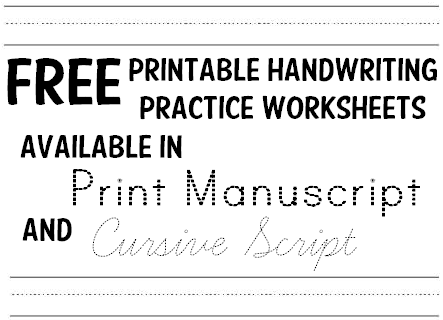 |
|---|
| www.studenthandouts.com > Handwriting Worksheets |
|---|
 Even in this modern digital age, the art of good, legible handwriting has not lost its importance in education. The manual dexterity taught when one writes is useful throughout life. And of course, the physical task of putting pen or pencil to paper, is shown to instill good spelling much more so than mere typing. Even in this modern digital age, the art of good, legible handwriting has not lost its importance in education. The manual dexterity taught when one writes is useful throughout life. And of course, the physical task of putting pen or pencil to paper, is shown to instill good spelling much more so than mere typing.Many schools now require that young students entering kindergarten be able to write the print manuscript alphabet, as well as their own names. This calls for free handwriting worksheets for parents and kids! While cursive script writing (sometimes called running writing) took a backseat for several years, its usefulness has been rediscovered, and students in the upper elementary grades are again learning how to write in cursive. We offer numerous free printable handwriting sheets for teaching your child or student this almost forgotten form of penmanship! |
|---|
| ↓ We have thousands of free writing practice printables—take your pick: ↓ |
 |
 |
 |
Handwriting, whether in print manuscript or cursive script, continues to be important in the digital age for several reasons.
Let's talk about it! Cognitive Benefits: Handwriting engages different cognitive processes than typing on a keyboard. It requires fine motor skills, visual recognition, and memory, which can aid in learning and retention. Studies have shown that students who take handwritten notes often retain information better than those who type their notes. Try it yourself to verify!
Cognitive Benefits: Handwriting engages different cognitive processes than typing on a keyboard. It requires fine motor skills, visual recognition, and memory, which can aid in learning and retention. Studies have shown that students who take handwritten notes often retain information better than those who type their notes. Try it yourself to verify!Personal Connection: Handwritten notes, letters, and cards carry a personal touch that digital messages lack. Handwriting allows individuals to convey emotion and personality through their unique script, making the communication more meaningful and memorable. Think about it--we have an emotional connection to things written by hand, not to things typed. Historical and Cultural Preservation: Handwritten documents and manuscripts are important for preserving historical and cultural heritage. Many historical documents, manuscripts, and artifacts are written by hand, and the ability to read and understand these materials is crucial for historians, researchers, and archivists. Is you child interested in history? Because it will be very hard to become a historian, without the ability to easily read the millions of documents written in cursive. Legal Documents and Signatures: Signatures on legal documents, contracts, and agreements are often required to be in handwritten form. The authenticity and legal validity of handwritten signatures are still highly valued in many jurisdictions. Imagine never perfecting your own autograph, ha ha ha! Education: Handwriting is an essential skill taught in schools as part of early literacy education. It helps children develop fine motor skills, hand-eye coordination, and an understanding of letter formation, which are foundational skills for learning to read and write effectively. Writing with pencils and pens in childhood is training the child's "muscle memory" for holding and using a small implement. Writing by hand is the easiest, most effective way to train those muscles. Accessibility: Not everyone has easy access to digital devices or may have physical limitations that make typing challenging. Handwriting ensures that information remains accessible to a broader population, including those who may not have digital resources. Imagine a power outage, and no one being able to simply write things down on paper quickly and legibly. Creativity and Expression: Handwriting allows for creative expression. Many artists and graphic designers incorporate hand-drawn elements into their work, adding a personal and artistic dimension to their creations. The best artists and designers first learned to draw and design by hand. Brain Engagement: Handwriting has been shown to stimulate the brain in unique ways, potentially enhancing cognitive function and creativity. It can also be a valuable tool for brainstorming and idea generation. Handwriting helps the human brain to make those connections! Practical Uses: In certain situations, such as filling out forms, taking quick notes, or jotting down ideas on the fly, handwriting can be more practical and efficient than using digital devices. Teaching Tool: Handwriting is often used as a teaching tool for language and literacy development. Learning to write by hand can reinforce language skills and help students develop better spelling and grammar. When writing by hand, kids are physically forming each letter--each letter's lines and curves. This is going to make them good spellers. (Side note: an informal poll at our office had everyone agreeing that constantly typing on our phones has hurt our spelling skills.) While digital communication is undeniably convenient and pervasive in modern society, handwriting retains its significance in various contexts, emphasizing the importance of maintaining this skill and appreciating its enduring value. So let's fire up our brain neurons! Let's build and exercise the muscle memory in our hands, and start writing. Our thousands of 100% free handwriting practice worksheets, in both print manuscript and cursive script, are here to help. Enjoy! |
| www.studenthandouts.com > Handwriting Worksheets |
|---|






